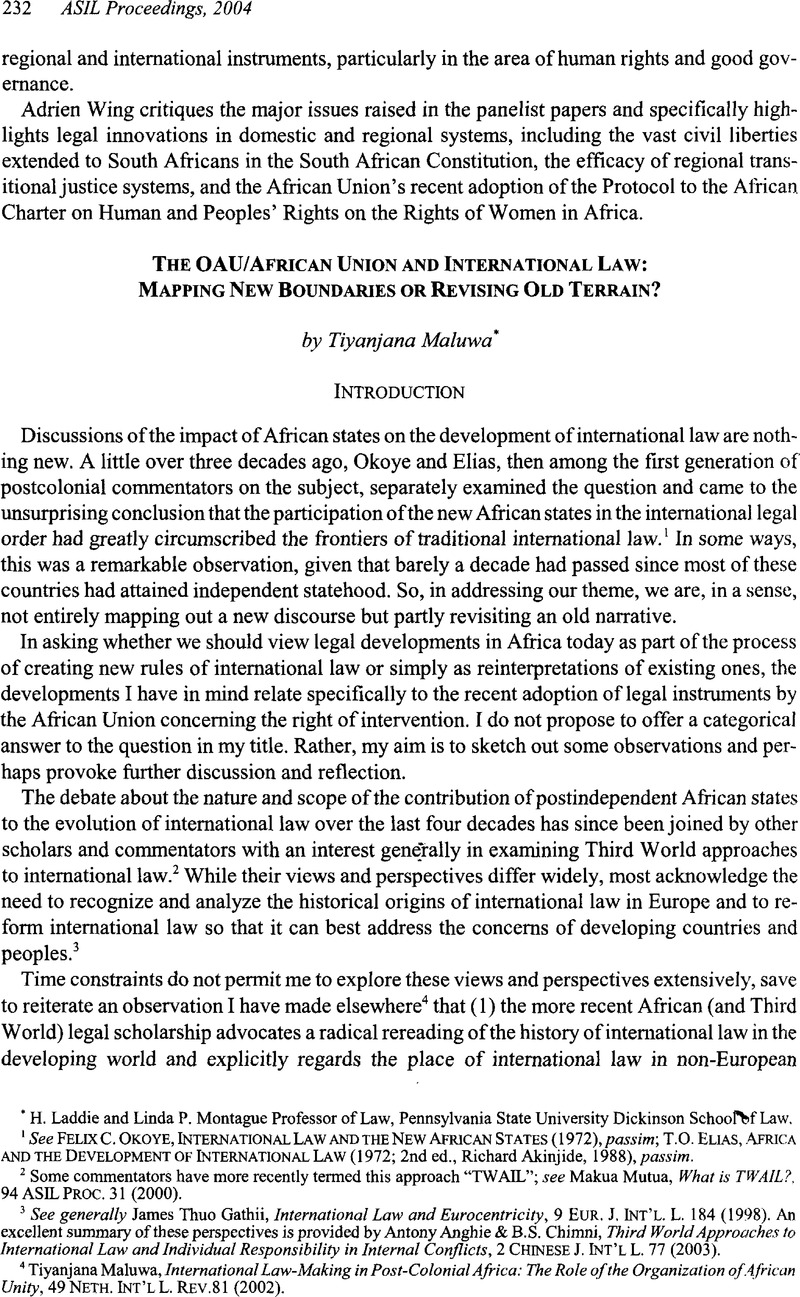Published online by Cambridge University Press: 28 February 2017

1 See Felix C. Okoye, International Law and the New African States (1972), passim; T. O. Elias, Africa and the Development of International Law (1972; 2nd ed., Richard Akinjide, 1988), passim.
2 Some commentators have more recently termed this approach “TWAIL”; see Mutua, Makua, What is TWAIL?. 94 ASIL Proc. 31 (2000)Google Scholar.
3 See generally Gathii, James Thuo, International Law and Eurocentricity, 9 Eur. J. Int’l. L. 184 (1998)CrossRefGoogle Scholar. An excellent summary of these perspectives is provided by Anghie, Antony & Chimni, B.S., Third World Approaches to International Law and Individual Responsibility in Internal Conflicts, 2 Chinese J. Int’l L. 77 (2003)CrossRefGoogle Scholar.
4 Maluwa, Tiyanjana, International Law-Making in Post-Colonial Africa: The Role of the Organization of African Unity, 49 Neth. Int’l L. Rev. 81 (2002)CrossRefGoogle Scholar.
5 Anghie & Chimni, supra note 3, at 78.
6 African Convention on the Conservation of Nature and Natural Resources, adopted on Sept. 15, 1968, available at <http://www.arrica-union.org/home/welcome.htm>.
7 African Charter on Human and People’s Rights, adopted June 27, 1981, 21 ILM 58 (1982); also available at <http://www.africa-union.org/home/welcome.htm>.
8 Bamako Convention on the Ban and the Import into Africa and Control of Transboundary Movement and Management of Hazardous Waste within Africa, adopted on Jan. 30, 10991, available at <http://www.africa-union.org/home/welcome.htm>.
9 OAU Convention Governing the Specific Aspects of Refugee Problems in Africa, adopted on Sept. 10, 1969, 1001 UNTS 45; also available at <http://www.africa-union.org/home/welcome.htm>.
10 See Mutua, Makau, The Banjul Charter and the African Cultural Fingerprint: An Evaluation of the Language of Duties, 35 Va. J. Int’l L. 339, 340 (1995)Google Scholar.
11 Constitutive Act of the African Union, adopted at the Thirty Sixth Ordinary Session of the Assembly of Heads of State and Government of the OAU, July 11, 2000, Lomé, Togo. See Decision on the Establishment of the African Union and the Pan African Parliament, OAU Doc. AHG/Dec. 143 (XXXVI).
12 I discuss at some length the amendments to the Constitutive Act in my forthcoming article, Fast-tracking African Unity? A Note on the Amendments to the Constitutive Act of the African Union, 51 Neth. Int’l L. Rev (forthcoming 2004)Google Scholar.
13 See generally, Baimu, E. and Sturman, K., Amendment to the African Union ‘s Right to Intervene: A Shift from Human Security to Regime Security? 12(2) Afr. Sec. Rev. (2003), available at <http://www.iss.co.za/Pubs/ASR/12No2/AfWat.htm>Google Scholar.
14 The idea that the ways in which a foreign government treated its “own” nationals was a matter for domestic jurisdiction only (domaine réservé) was widely accepted in international law in the pre-UN Charter era, before international concern for human rights took hold. See Simma, Bruno, Human Rights, in The United Nations At Age Fifty. A Legal Perspective 263 (Tomuschat, Christian, ed., 1995)Google Scholar, 266.
15 Id., at 5.
16 Phillipe Sands & Pierre Klein, Bowett’s Law of International Institutions 51-52 (2001).
17 AHG/Decl.5 (XXXVI).
18 AHG/Decl.l (XXXVIII).
19 See Protocol Relating to the Establishment of the Peace and Security Council of the African Union, Article 7(r). On cooperation with the UN Security Council, see id., Article 17(1) and (3).
20 The official AU Web site indicates that as of March, 17, 2004, South Africa had ratified the protocol. However, the information shows that South Africa ratified it on March 20, 2004, signed it on March 16, 2004, and deposited the instrument of ratification also on March 16, 2004. This chronology does not make sense. On the face of it, it would not be consistent with the procedure under the South African constitution, which requires that the president sign an international treaty before Parliament ratifies it.
21 Levitt, Jeremy, Conflict Prevention, Management, and Resolution: Africa-Regional Strategies for the Prevention of Displacement and Protection of Displaced Persons: The Cases of the OAU, ECOWAS, SADC, and IG AD, 11 Duke J. Comp. & Int’l L. 39, 79 (2001)Google Scholar.